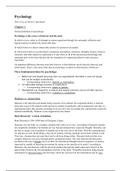Psychology
Peter Gray & David F. Bjorklund
Chapter 1
Formal definition of psychology:
Psychology is the science of behavior and the mind.
In which science refers to all attempts to answer questions through the systematic collection and
logical analysis of objectively observable data.
In which behavior refers to observable actions of a person or an animal.
In which mind refers to an individual’s sensations, perceptions, memories, thoughts, dreams, motives,
emotions, and other subjective experiences. It also refers to all of the unconscious knowledge and
operating rules in the brain that provide the foundation for organizing behavior and conscious
experience.
An important difference between mind and behavior is that behavior can be directly observed, and
mind cannot. That is why most of the data in psychology is based on observations of behavior.
Three fundamental ideas for psychology:
1. Behaviour and mental processes have no supernatural, but rather a material origin,
that can be studied scientifically.
Corresponding controversy: dualism vs. materialism.
2. An individual changes because of experiences.
Corresponding controversy: nature vs. nurture.
3. Humankind was shaped by evolution and natural selection, just as all other species.
Corresponding controversy: evolution vs. creationism.
Dualism vs. materialism
Dualism is the idea that each human being consists of two distinct but conjoined entities, a material
body that is part of the natural world and can be studied scientifically, and an immaterial soul that is a
supernatural entity that operates according to its own free will, not natural law, and therefore cannot be
studied scientifically. Dualism is also supported by the church.
René Descartes’ version of dualism
René Descartes (1596-1650) born in Descartes, France.
Descartes saw the body as a complex machine that works on its own. According to Descartes animals
are completely mechanic, but humans are not, because humans have conscious thought. Descartes was
the first to assign a lot of qualities of humans not to the soul, but to the body. With the reasoning that,
if a dog has no soul, all the things a dog can do (eating, running, panting) can be done without a soul.
That way, a human does not need their soul to do these things either. Descartes believed that even
complex behaviors can occur through purely mechanical means. The only function that Descartes
ascribed to the soul is thought, but even then, he still believed thought must be responsive to sensory
input and be capable of directing movements by acting on the muscles to be useful. According to
Descartes, the soul interacts with the physical machine through the small organ (now known as the
pineal body) between the two hemispheres (halves) of the brain. Threadlike structures bring sensory
information by physical means into the brain, where the soul receives the information and, by non-
, physical means thinks about it. On the basis of those thoughts, the soul executes its will by triggering
physical action in the nerves that, in turn, act on the muscles. Descartes dualism helped open the door
for the science of psychology. Descartes’ theory is still popular by this day because it acknowledges
the existence of physical means within the body without violating religious believes or intuitive
feelings.
Limitations: As a philosophy it stumbles upon the questions, how can something non-material have a
material effect? And how can the body follow natural law and be moved by a soul that does not? As a
foundation for psychology the theory sets strict limits on what can and cannot be understood
scientifically. Thought and the behaviors that come from thought cannot be scientifically analyzed if
they are the products of a willful soul.
Descartes’ depiction of a reflex:
Explanation: The fire causes movement in the nearby particles in the skin, pulling on a thread
(running from ‘C’ to ‘C’) going to the brain, which opens a pore in the brain allowing fluid to flow
through a ‘small conduit’ to the muscles that withdraw the foot. Today we know the ‘thread’ and
‘small conduit’ are actual nerves and that nerves operate through electrical means.
Descartes’ depiction of how the soul receives information through the eyes:
Explanation: The human soul is located in the tear shaped object which Descartes called the ‘pineal
gland’. Light from the arrow enters the eyes and opens pores in structures that we now know as the
optic nerves. Fluid flows from the eyes through the opened pores, causing movement in the pineal
gland which renders the idea of the arrow to the soul.
Thomas Hobbes and the Philosophy of Materialism
Thomas Hobbes (1588-1679) born in Westport, England.
Hobbes argues that spirit, or soul is a meaningless concept and that nothing exists but matter and
energy, a philosophy known as materialism. All human behavior can be explained by physical
processes in the body and especially the brain. Conscious thought is a product of the brain’s
machinery and therefore subject to natural law. This philosophy places no limit on scientific studies.
Hobbes’ ideas helped inspire empiricism.





